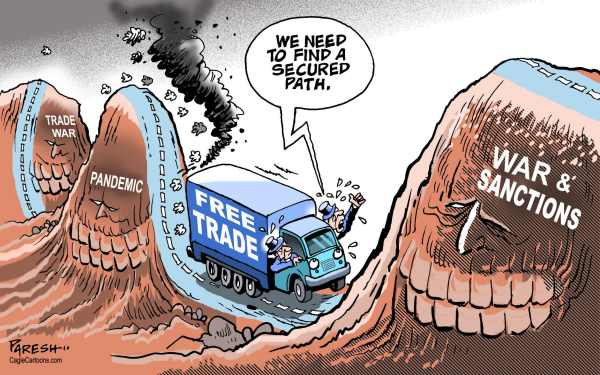The Price of War: How Global Conflicts Affect Your Wallet In a world increasingly connected through trade, technology, and culture, the effects of war can ripple far beyond the borders of the warring nations. While the human cost of conflict is often discussed in terms of lives lost, refugees displaced, and cities destroyed, there is another, perhaps less visible, but equally important toll: the economic impact of world conflict. The consequences of global wars, whether direct or indirect, stretch into the pockets of ordinary citizens, raising the price of goods, shifting investment patterns, and affecting the global economy in profound ways. The price of war, it seems, is not only measured in battles fought but also in the economic repercussions that follow.
The cost of conflict extends far beyond military expenditures. This article explores how global conflicts affect your wallet, breaking down the far-reaching consequences of war and explaining how international conflicts can influence everything from the price of bread to the stock market.

The Global Economy: A Tightly Woven Fabric
The intricate web of global trade means that the actions of one country can trigger a chain reaction that affects others. A conflict in a major oil-producing region, for instance, can disrupt global energy markets, while a trade war can send ripples through the supply chains of goods and services. These interconnected systems ensure that the economic impact of world conflict extends well beyond the borders of the nations involved.
The primary mechanism by which global conflicts affect economies is through the disruption of trade. The result? Supply shortages that drive up the prices of everyday items, such as food, fuel, and consumer goods.
The Cost of War on Resources
One of the most direct ways in which war impacts the global economy is through the disruption of resource supply chains. Many global conflicts occur in regions rich in natural resources—oil, gas, minerals, and metals—that are critical to the world’s industries. When these resources become difficult to access due to conflict, it can result in price hikes and scarcity, placing a strain on economies far from the frontline.
Consider the example of the Middle East, home to some of the world’s largest oil reserves. Wars and instability in the region often lead to fluctuations in oil prices, as global markets respond to the uncertainty surrounding the supply of energy. A rise in oil prices translates to higher transportation costs, which, in turn, increases the price of goods ranging from food to electronics.
Similarly, conflicts in resource-rich regions like Africa or Latin America can have far-reaching effects on global commodity prices. Whether it’s the mining of precious metals in conflict zones or the disruption of agricultural production, war places a premium on the goods that these regions provide. The resulting price increases can add significant pressure to global economies, affecting consumers everywhere.
Inflation: A Silent Culprit
When war disrupts the flow of goods and resources, one of the most immediate consequences is inflation. Inflation occurs when the general price level of goods and services rises, eroding purchasing power. The economic impact of world conflict on inflation can be swift and severe, especially when essential goods such as food, medicine, and energy are impacted.
For example, during the 1970s oil crisis, wars in the Middle East led to a massive spike in oil prices, which in turn caused widespread inflation in many countries. The cost of living soared as the price of gasoline, heating oil, and other energy sources climbed, and the global economy faced a period of stagflation—an unsettling mix of stagnation and inflation that challenged policymakers.
Today, inflation is still a concern in countries that experience the fallout from global conflicts. Even if a conflict occurs in a region far from one’s own borders, the economic consequences of war can create inflationary pressures that impact everyday expenses. The resulting increase in prices diminishes the purchasing power of individuals, making it harder to stretch a paycheck and forcing people to reconsider their spending habits.
The Ripple Effect on Food Prices
One of the most immediate ways in which conflicts impact consumers is through rising food prices. War disrupts agricultural production, either through direct damage to farmland or by causing shortages in labor and fertilizer. When countries at the center of global trade supply chains go to war, the result can be a dramatic spike in food prices worldwide.
In 2007-2008, food prices soared due to a combination of factors, including the impact of war and political instability in regions such as the Middle East and parts of Africa. The cost of staple items like rice, wheat, and corn skyrocketed, pushing millions of people into poverty and increasing food insecurity in many parts of the world.
Additionally, when conflicts disrupt food production in one part of the world, other countries may struggle to fill the void. For instance, if war prevents a country from exporting grains, the global market may have to find alternative suppliers, which can drive up the cost of food worldwide. This puts strain on consumers, particularly in developing nations, where food is a significant portion of household spending.
The Military-Industrial Complex: A Costly Enterprise
War, by its very nature, requires significant investment in military expenditure. Governments must fund the development and procurement of weapons, personnel, and equipment to wage conflict. This often results in skyrocketing national budgets for defense, diverting funds from other sectors such as education, healthcare, and infrastructure. For the average citizen, the increased allocation of government spending toward military efforts can result in higher taxes, reduced public services, and greater debt.
Government Spending and National Debt
One of the most visible effects of global conflict on a nation’s economy is the increase in government spending. When a country enters a war, it must allocate a substantial portion of its budget to military operations. This spending often leads to higher national debt, as governments borrow money to finance the war effort. As national debt increases, countries may face higher interest rates on loans, putting additional strain on their finances.
For example, the United States’ involvement in the Iraq and Afghanistan wars led to a dramatic increase in the national debt, which has had lasting effects on the country’s economy. In the years following the wars, the U.S. government continued to spend heavily on military operations, which compounded the fiscal challenges faced by the country. As a result, ordinary citizens felt the effects of these budgetary decisions in the form of higher taxes, reduced public spending, and a shrinking social safety net.
In addition to government spending, wars often lead to an increase in military contracts and the growth of the military-industrial complex. While this can stimulate certain sectors of the economy, it can also lead to a misallocation of resources.
Financial Markets: Uncertainty and Instability
War creates uncertainty, and uncertainty breeds instability in financial markets. Investors dislike unpredictability, and as conflicts escalate, they may pull investments from risky markets or adopt a more conservative approach to investing. Stock markets often react negatively to global conflicts, with stock prices falling as companies’ future profits become uncertain.
For example, during the Gulf War in the early 1990s, stock markets around the world experienced significant volatility as investors reacted to the uncertainty surrounding the conflict. Similarly, in the aftermath of the 9/11 attacks, financial markets plummeted as the global economy grappled with the fallout from terrorism and war.
Wars also lead to fluctuations in currency values. When a country is at war, its currency may lose value due to decreased confidence from foreign investors, leading to inflation and further economic instability. This can make it more expensive for citizens to travel abroad, purchase foreign goods, or invest in international markets.
The Impact on Global Trade and Supply Chains
Trade is one of the pillars of the global economy, and war can severely disrupt international supply chains. Countries at the center of trade routes may find their ports and infrastructure damaged, leading to delays and shortages in the delivery of goods. Furthermore, conflicts often cause trade barriers to rise, as countries impose sanctions or tariffs on one another in response to hostilities.
The result is a slowdown in global trade, which can have significant economic repercussions. For businesses, the inability to source goods from overseas can increase operational costs, while consumers may find that certain products are harder to come by or more expensive. Even countries that are not directly involved in a conflict can feel the effects through the disruption of trade flows and the increased cost of goods.
Conclusion: The Price of War is Always Paid by the People
The economic impact of world conflict is profound and far-reaching, touching everything from the price of basic commodities to the stability of global markets. While the military and political consequences of war are often the focus of news headlines, the economic repercussions are just as significant and have long-lasting effects on everyday life.
For consumers, the price of war is not just measured in the taxes they pay or the increased cost of living but also in the loss of opportunity, jobs, and the erosion of wealth. The economic ramifications of conflict affect individuals across the world, whether directly or indirectly, and it is clear that no one escapes unscathed.
In the end, the true cost of war is not only in lives lost but also in the financial burdens carried by future generations. The ripple effects of global conflicts are felt long after the guns fall silent, shaping the global economy in ways that can last for decades. As the world continues to grapple with conflicts, the price of war remains a harsh reminder of the complex and interconnected nature of our global society.




